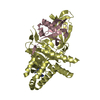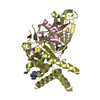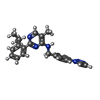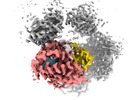[English] 日本語
 Yorodumi
Yorodumi- EMDB-50317: USP1 bound to ML323 and ubiquitin conjugated to FANCD2 (ordered s... -
+ Open data
Open data
- Basic information
Basic information
| Entry |  | |||||||||
|---|---|---|---|---|---|---|---|---|---|---|
| Title | USP1 bound to ML323 and ubiquitin conjugated to FANCD2 (ordered subset, focused refinement) | |||||||||
 Map data Map data | Globally sharpened map (B-factor 81.5) | |||||||||
 Sample Sample |
| |||||||||
 Keywords Keywords | INHIBITOR / DEUBIQUITINASE / COMPLEX / ENZYME-SUBSTRATE / HYDROLASE | |||||||||
| Function / homology |  Function and homology information Function and homology informationpositive regulation of error-prone translesion synthesis / monoubiquitinated protein deubiquitination / protein deubiquitination / regulation of DNA repair / response to UV / Maturation of protein E / Maturation of protein E / ER Quality Control Compartment (ERQC) / Myoclonic epilepsy of Lafora / IRAK2 mediated activation of TAK1 complex ...positive regulation of error-prone translesion synthesis / monoubiquitinated protein deubiquitination / protein deubiquitination / regulation of DNA repair / response to UV / Maturation of protein E / Maturation of protein E / ER Quality Control Compartment (ERQC) / Myoclonic epilepsy of Lafora / IRAK2 mediated activation of TAK1 complex / Alpha-protein kinase 1 signaling pathway / FLT3 signaling by CBL mutants / IRAK1 recruits IKK complex / IRAK1 recruits IKK complex upon TLR7/8 or 9 stimulation / Prevention of phagosomal-lysosomal fusion / Glycogen synthesis / IRAK2 mediated activation of TAK1 complex upon TLR7/8 or 9 stimulation / Regulation of TBK1, IKKε (IKBKE)-mediated activation of IRF3, IRF7 / Endosomal Sorting Complex Required For Transport (ESCRT) / TICAM1,TRAF6-dependent induction of TAK1 complex / Membrane binding and targetting of GAG proteins / Regulation of TBK1, IKKε-mediated activation of IRF3, IRF7 upon TLR3 ligation / Negative regulation of FLT3 / Constitutive Signaling by NOTCH1 HD Domain Mutants / PTK6 Regulates RTKs and Their Effectors AKT1 and DOK1 / Regulation of FZD by ubiquitination / TICAM1-dependent activation of IRF3/IRF7 / NOTCH2 Activation and Transmission of Signal to the Nucleus / p75NTR recruits signalling complexes / APC/C:Cdc20 mediated degradation of Cyclin B / Downregulation of ERBB4 signaling / TRAF6-mediated induction of TAK1 complex within TLR4 complex / TRAF6 mediated IRF7 activation in TLR7/8 or 9 signaling / APC-Cdc20 mediated degradation of Nek2A / Regulation of innate immune responses to cytosolic DNA / NF-kB is activated and signals survival / InlA-mediated entry of Listeria monocytogenes into host cells / Regulation of pyruvate metabolism / VLDLR internalisation and degradation / Downregulation of ERBB2:ERBB3 signaling / NRIF signals cell death from the nucleus / Pexophagy / Activated NOTCH1 Transmits Signal to the Nucleus / Regulation of PTEN localization / Regulation of BACH1 activity / Synthesis of active ubiquitin: roles of E1 and E2 enzymes / TICAM1, RIP1-mediated IKK complex recruitment / Translesion synthesis by REV1 / MAP3K8 (TPL2)-dependent MAPK1/3 activation / Translesion synthesis by POLK / Downregulation of TGF-beta receptor signaling / Activation of IRF3, IRF7 mediated by TBK1, IKKε (IKBKE) / Translesion synthesis by POLI / PINK1-PRKN Mediated Mitophagy / IKK complex recruitment mediated by RIP1 / Regulation of activated PAK-2p34 by proteasome mediated degradation / JNK (c-Jun kinases) phosphorylation and activation mediated by activated human TAK1 / Gap-filling DNA repair synthesis and ligation in GG-NER / Josephin domain DUBs / InlB-mediated entry of Listeria monocytogenes into host cell / TGF-beta receptor signaling in EMT (epithelial to mesenchymal transition) / TNFR1-induced NF-kappa-B signaling pathway / N-glycan trimming in the ER and Calnexin/Calreticulin cycle / Autodegradation of Cdh1 by Cdh1:APC/C / skeletal system development / APC/C:Cdc20 mediated degradation of Securin / Regulation of NF-kappa B signaling / SCF-beta-TrCP mediated degradation of Emi1 / Asymmetric localization of PCP proteins / TCF dependent signaling in response to WNT / NIK-->noncanonical NF-kB signaling / Ubiquitin-dependent degradation of Cyclin D / AUF1 (hnRNP D0) binds and destabilizes mRNA / activated TAK1 mediates p38 MAPK activation / TNFR2 non-canonical NF-kB pathway / Vpu mediated degradation of CD4 / Negative regulators of DDX58/IFIH1 signaling / NOTCH3 Activation and Transmission of Signal to the Nucleus / Assembly of the pre-replicative complex / Degradation of DVL / Deactivation of the beta-catenin transactivating complex / Ubiquitin Mediated Degradation of Phosphorylated Cdc25A / Regulation of signaling by CBL / Dectin-1 mediated noncanonical NF-kB signaling / positive regulation of receptor signaling pathway via JAK-STAT / Cdc20:Phospho-APC/C mediated degradation of Cyclin A / Fanconi Anemia Pathway / Negative regulation of FGFR3 signaling / Hh mutants are degraded by ERAD / Degradation of AXIN / Peroxisomal protein import / Activation of NF-kappaB in B cells / Regulation of TNFR1 signaling / Degradation of GLI1 by the proteasome / Recognition of DNA damage by PCNA-containing replication complex / Negative regulation of FGFR2 signaling / Downregulation of SMAD2/3:SMAD4 transcriptional activity / Stabilization of p53 / EGFR downregulation / Hedgehog ligand biogenesis Similarity search - Function | |||||||||
| Biological species |  Homo sapiens (human) Homo sapiens (human) | |||||||||
| Method | single particle reconstruction / cryo EM / Resolution: 2.7 Å | |||||||||
 Authors Authors | Rennie ML / Gundogdu M / Walden H | |||||||||
| Funding support |  United Kingdom, 1 items United Kingdom, 1 items
| |||||||||
 Citation Citation |  Journal: J Med Chem / Year: 2024 Journal: J Med Chem / Year: 2024Title: Structural and Biochemical Insights into the Mechanism of Action of the Clinical USP1 Inhibitor, KSQ-4279. Authors: Martin Luke Rennie / Mehmet Gundogdu / Connor Arkinson / Steven Liness / Sheelagh Frame / Helen Walden /  Abstract: DNA damage triggers cell signaling cascades that mediate repair. This signaling is frequently dysregulated in cancers. The proteins that mediate this signaling are potential targets for therapeutic ...DNA damage triggers cell signaling cascades that mediate repair. This signaling is frequently dysregulated in cancers. The proteins that mediate this signaling are potential targets for therapeutic intervention. Ubiquitin-specific protease 1 (USP1) is one such target, with small-molecule inhibitors already in clinical trials. Here, we use biochemical assays and cryo-electron microscopy (cryo-EM) to study the clinical USP1 inhibitor, KSQ-4279 (RO7623066), and compare this to the well-established tool compound, ML323. We find that KSQ-4279 binds to the same cryptic site of USP1 as ML323 but disrupts the protein structure in subtly different ways. Inhibitor binding drives a substantial increase in thermal stability of USP1, which may be mediated through the inhibitors filling a hydrophobic tunnel-like pocket in USP1. Our results contribute to the understanding of the mechanism of action of USP1 inhibitors at the molecular level. | |||||||||
| History |
|
- Structure visualization
Structure visualization
| Supplemental images |
|---|
- Downloads & links
Downloads & links
-EMDB archive
| Map data |  emd_50317.map.gz emd_50317.map.gz | 118.1 MB |  EMDB map data format EMDB map data format | |
|---|---|---|---|---|
| Header (meta data) |  emd-50317-v30.xml emd-50317-v30.xml emd-50317.xml emd-50317.xml | 18.8 KB 18.8 KB | Display Display |  EMDB header EMDB header |
| FSC (resolution estimation) |  emd_50317_fsc.xml emd_50317_fsc.xml | 11.9 KB | Display |  FSC data file FSC data file |
| Images |  emd_50317.png emd_50317.png | 89.1 KB | ||
| Masks |  emd_50317_msk_1.map emd_50317_msk_1.map emd_50317_msk_2.map emd_50317_msk_2.map emd_50317_msk_3.map emd_50317_msk_3.map | 125 MB 125 MB 30.5 MB |  Mask map Mask map | |
| Filedesc metadata |  emd-50317.cif.gz emd-50317.cif.gz | 6.9 KB | ||
| Others |  emd_50317_half_map_1.map.gz emd_50317_half_map_1.map.gz emd_50317_half_map_2.map.gz emd_50317_half_map_2.map.gz | 116.1 MB 116.1 MB | ||
| Archive directory |  http://ftp.pdbj.org/pub/emdb/structures/EMD-50317 http://ftp.pdbj.org/pub/emdb/structures/EMD-50317 ftp://ftp.pdbj.org/pub/emdb/structures/EMD-50317 ftp://ftp.pdbj.org/pub/emdb/structures/EMD-50317 | HTTPS FTP |
-Validation report
| Summary document |  emd_50317_validation.pdf.gz emd_50317_validation.pdf.gz | 1.1 MB | Display |  EMDB validaton report EMDB validaton report |
|---|---|---|---|---|
| Full document |  emd_50317_full_validation.pdf.gz emd_50317_full_validation.pdf.gz | 1.1 MB | Display | |
| Data in XML |  emd_50317_validation.xml.gz emd_50317_validation.xml.gz | 18.9 KB | Display | |
| Data in CIF |  emd_50317_validation.cif.gz emd_50317_validation.cif.gz | 24.3 KB | Display | |
| Arichive directory |  https://ftp.pdbj.org/pub/emdb/validation_reports/EMD-50317 https://ftp.pdbj.org/pub/emdb/validation_reports/EMD-50317 ftp://ftp.pdbj.org/pub/emdb/validation_reports/EMD-50317 ftp://ftp.pdbj.org/pub/emdb/validation_reports/EMD-50317 | HTTPS FTP |
-Related structure data
| Related structure data |  9fcjMC  9fciC M: atomic model generated by this map C: citing same article ( |
|---|---|
| Similar structure data | Similarity search - Function & homology  F&H Search F&H Search |
- Links
Links
| EMDB pages |  EMDB (EBI/PDBe) / EMDB (EBI/PDBe) /  EMDataResource EMDataResource |
|---|---|
| Related items in Molecule of the Month |
- Map
Map
| File |  Download / File: emd_50317.map.gz / Format: CCP4 / Size: 125 MB / Type: IMAGE STORED AS FLOATING POINT NUMBER (4 BYTES) Download / File: emd_50317.map.gz / Format: CCP4 / Size: 125 MB / Type: IMAGE STORED AS FLOATING POINT NUMBER (4 BYTES) | ||||||||||||||||||||||||||||||||||||
|---|---|---|---|---|---|---|---|---|---|---|---|---|---|---|---|---|---|---|---|---|---|---|---|---|---|---|---|---|---|---|---|---|---|---|---|---|---|
| Annotation | Globally sharpened map (B-factor 81.5) | ||||||||||||||||||||||||||||||||||||
| Projections & slices | Image control
Images are generated by Spider. | ||||||||||||||||||||||||||||||||||||
| Voxel size | X=Y=Z: 1.06 Å | ||||||||||||||||||||||||||||||||||||
| Density |
| ||||||||||||||||||||||||||||||||||||
| Symmetry | Space group: 1 | ||||||||||||||||||||||||||||||||||||
| Details | EMDB XML:
|
-Supplemental data
-Mask #1
| File |  emd_50317_msk_1.map emd_50317_msk_1.map | ||||||||||||
|---|---|---|---|---|---|---|---|---|---|---|---|---|---|
| Projections & Slices |
| ||||||||||||
| Density Histograms |
-Mask #2
| File |  emd_50317_msk_2.map emd_50317_msk_2.map | ||||||||||||
|---|---|---|---|---|---|---|---|---|---|---|---|---|---|
| Projections & Slices |
| ||||||||||||
| Density Histograms |
-Mask #3
| File |  emd_50317_msk_3.map emd_50317_msk_3.map | ||||||||||||
|---|---|---|---|---|---|---|---|---|---|---|---|---|---|
| Projections & Slices |
| ||||||||||||
| Density Histograms |
- Sample components
Sample components
-Entire : USP1 BOUND TO ML323 AND UBIQUITIN CONJUGATED TO FANCD2
| Entire | Name: USP1 BOUND TO ML323 AND UBIQUITIN CONJUGATED TO FANCD2 |
|---|---|
| Components |
|
-Supramolecule #1: USP1 BOUND TO ML323 AND UBIQUITIN CONJUGATED TO FANCD2
| Supramolecule | Name: USP1 BOUND TO ML323 AND UBIQUITIN CONJUGATED TO FANCD2 type: complex / ID: 1 / Parent: 0 / Macromolecule list: #1-#2 |
|---|---|
| Source (natural) | Organism:  Homo sapiens (human) Homo sapiens (human) |
-Macromolecule #1: Polyubiquitin-C
| Macromolecule | Name: Polyubiquitin-C / type: protein_or_peptide / ID: 1 / Number of copies: 1 / Enantiomer: LEVO |
|---|---|
| Source (natural) | Organism:  Homo sapiens (human) Homo sapiens (human) |
| Molecular weight | Theoretical: 8.875125 KDa |
| Recombinant expression | Organism:  |
| Sequence | String: GPGSMQIFVK TLTGKTITLE VEPSDTIENV KAKIQDKEGI PPDQQRLIFA GKQLEDGRTL SDYNIQKEST LHLVLRLRGG UniProtKB: Polyubiquitin-C |
-Macromolecule #2: Ubiquitin carboxyl-terminal hydrolase 1
| Macromolecule | Name: Ubiquitin carboxyl-terminal hydrolase 1 / type: protein_or_peptide / ID: 2 / Number of copies: 1 / Enantiomer: LEVO / EC number: ubiquitinyl hydrolase 1 |
|---|---|
| Source (natural) | Organism:  Homo sapiens (human) Homo sapiens (human) |
| Molecular weight | Theoretical: 88.390273 KDa |
| Recombinant expression | Organism:  |
| Sequence | String: GMPGVIPSES NGLSRGSPSK KNRLSLKFFQ KKETKRALDF TDSQENEEKA SEYRASEIDQ VVPAAQSSPI NCEKRENLLP FVGLNNLGN TSYLNSILQV LYFCPGFKSG VKHLFNIISR KKEALKDEAN QKDKGNCKED SLASYELICS LQSLIISVEQ L QASFLLNP ...String: GMPGVIPSES NGLSRGSPSK KNRLSLKFFQ KKETKRALDF TDSQENEEKA SEYRASEIDQ VVPAAQSSPI NCEKRENLLP FVGLNNLGN TSYLNSILQV LYFCPGFKSG VKHLFNIISR KKEALKDEAN QKDKGNCKED SLASYELICS LQSLIISVEQ L QASFLLNP EKYTDELATQ PRRLLNTLRE LNPMYEGYLQ HDAQEVLQCI LGNIQETCQL LKKEEVKNVA ELPTKVEEIP HP KEEMNGI NSIEMDSMRH SEDFKEKLPK GNGKRKSDTE FGNMKKKVKL SKEHQSLEEN QRQTRSKRKA TSDTLESPPK IIP KYISEN ESPRPSQKKS RVKINWLKSA TKQPSILSKF CSLGKITTNQ GVKGQSKENE CDPEEDLGKC ESDNTTNGCG LESP GNTVT PVNVNEVKPI NKGEEQIGFE LVEKLFQGQL VLRTRCLECE SLTERREDFQ DISVPVQEDE LSKVEESSEI SPEPK TEMK TLRWAISQFA SVERIVGEDK YFCENCHHYT EAERSLLFDK MPEVITIHLK CFAASGLEFD CYGGGLSKIN TPLLTP LKL SLEEWSTKPT NDSYGLFAVV MHSGITISSG HYTASVKVTD LNSLELDKGN FVVDQMCEIG KPEPLNEEEA RGVVENY ND EEVSIRVGGN TQPSKVLNKK NVEAIGLLAA QKSKADYELY NKASNPDKVA STAFAENRNS ETSDTTGTHE SDRNKESS D QTGINISGFE NKISYVVQSL KEYEGKWLLF DDSEVKVTEE KDFLNSLSPS TSPTSTPYLL FYKKL UniProtKB: Ubiquitin carboxyl-terminal hydrolase 1 |
-Macromolecule #3: ZINC ION
| Macromolecule | Name: ZINC ION / type: ligand / ID: 3 / Number of copies: 1 / Formula: ZN |
|---|---|
| Molecular weight | Theoretical: 65.409 Da |
-Macromolecule #4: 5-methyl-2-(2-propan-2-ylphenyl)-~{N}-[[4-(1,2,3-triazol-1-yl)phe...
| Macromolecule | Name: 5-methyl-2-(2-propan-2-ylphenyl)-~{N}-[[4-(1,2,3-triazol-1-yl)phenyl]methyl]pyrimidin-4-amine type: ligand / ID: 4 / Number of copies: 1 / Formula: JDA |
|---|---|
| Molecular weight | Theoretical: 384.477 Da |
| Chemical component information |  ChemComp-JDA: |
-Macromolecule #5: water
| Macromolecule | Name: water / type: ligand / ID: 5 / Number of copies: 29 / Formula: HOH |
|---|---|
| Molecular weight | Theoretical: 18.015 Da |
| Chemical component information |  ChemComp-HOH: |
-Experimental details
-Structure determination
| Method | cryo EM |
|---|---|
 Processing Processing | single particle reconstruction |
| Aggregation state | particle |
- Sample preparation
Sample preparation
| Buffer | pH: 8 |
|---|---|
| Grid | Model: UltrAuFoil R1.2/1.3 / Mesh: 300 |
| Vitrification | Cryogen name: ETHANE / Chamber humidity: 95 % / Chamber temperature: 288 K / Instrument: FEI VITROBOT MARK IV / Details: blotting for 3.0 seconds. |
| Details | 9.3 uM USP1-UAF1, 1.8 uM FANCI-FANCD2Ub, 2.2 uM dsDNA (61 base-pairs), 18 uM ML323 |
- Electron microscopy
Electron microscopy
| Microscope | TFS KRIOS |
|---|---|
| Image recording | Film or detector model: GATAN K3 (6k x 4k) / Average electron dose: 40.0 e/Å2 |
| Electron beam | Acceleration voltage: 300 kV / Electron source:  FIELD EMISSION GUN FIELD EMISSION GUN |
| Electron optics | Illumination mode: FLOOD BEAM / Imaging mode: BRIGHT FIELD / Nominal defocus max: 3.0 µm / Nominal defocus min: 1.0 µm |
| Experimental equipment |  Model: Titan Krios / Image courtesy: FEI Company |
 Movie
Movie Controller
Controller





















 Z (Sec.)
Z (Sec.) Y (Row.)
Y (Row.) X (Col.)
X (Col.)














































